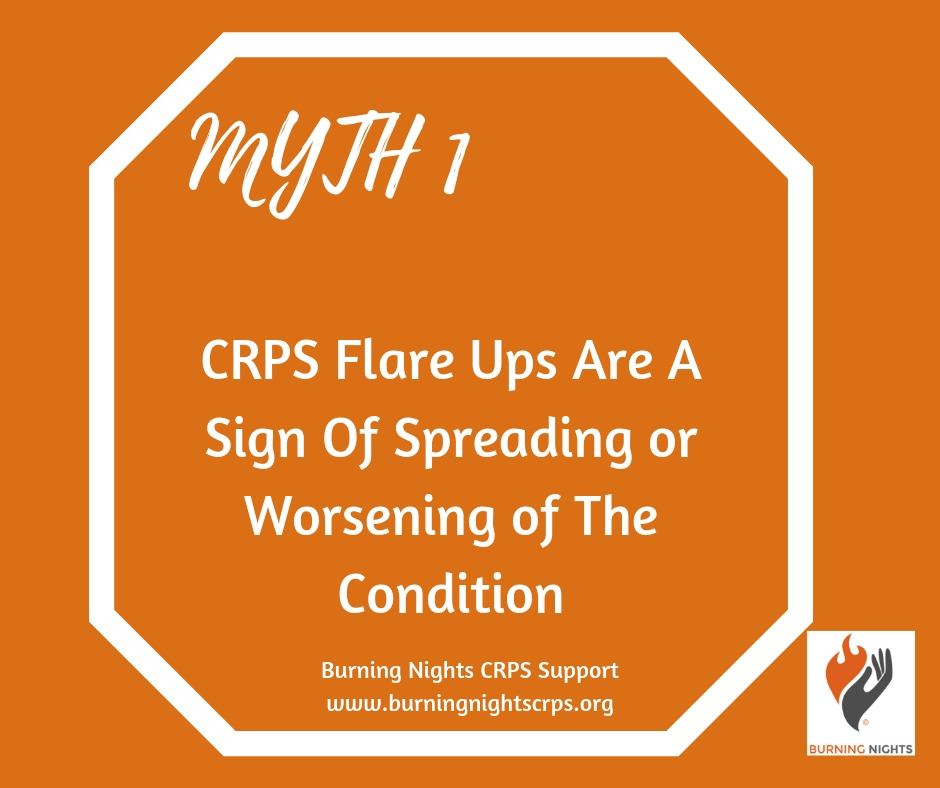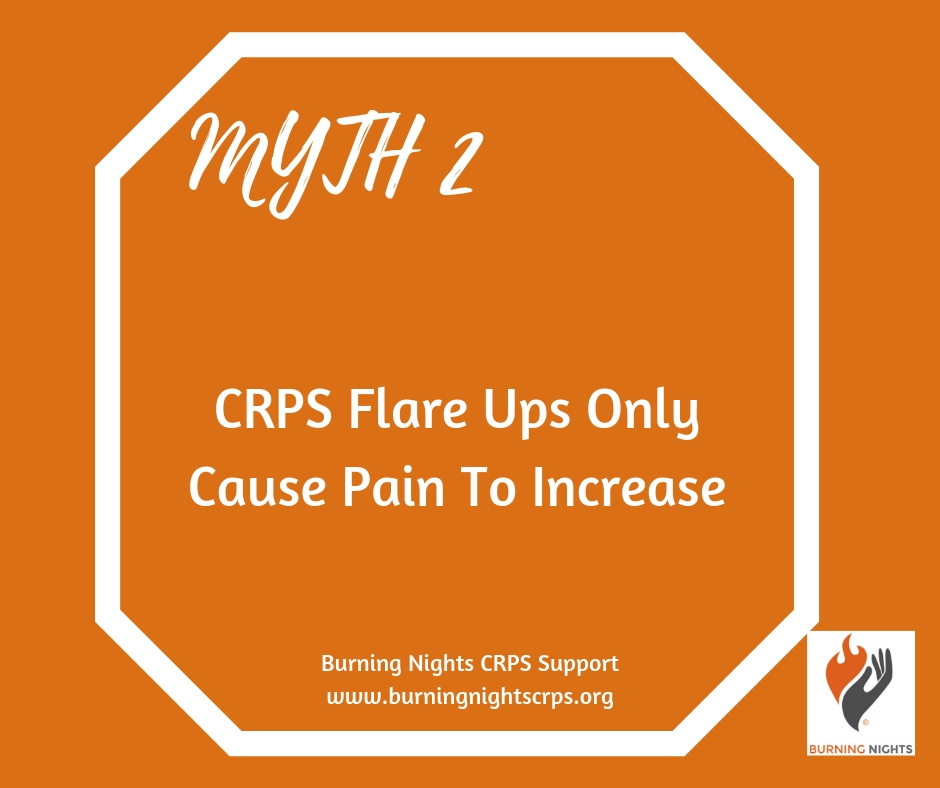We use cookies to improve your experience. By accepting you agree to our cookie policy

Complex Regional Pain Syndrome (CRPS) is a chronic neuropathic pain condition that was formerly known as Reflex Sympathetic Dystrophy (RSD). It is a very painful, difficult and ‘complex’ condition not only to diagnose but to also treat. CRPS is also difficult condition to understand for both patients and their families.
This article discusses the main myths of CRPS Flare Ups, also known as CRPS Flares, but also 5 common myths of CRPS Flare Ups. To learn about how to manage your CRPS flare ups, please visit our page 'How to Manage Your CRPS Flare Up.'

Most if not all CRPS patients will have at some or many points throughout their condition an acute flare up of their symptoms especially their pain levels. This is where a CRPS patient will experience a spike or an increase in their pain and other symptoms.
A flare according to the dictionary is defined as ‘to burn with a sudden intensity; (of an illness or chronic medical complaint): to recur unexpectedly and cause further discomfort.’
For many patients they will go to the Hospital Emergency Department for several reasons including not being aware that their CRPS is flaring up or they are simply not able to cope with the sheer high level of pain and other symptoms that they may be feeling.

CRPS Flares or flare ups are debilitating and in some patients it can mimic other conditions such as cellulitis or a dermatological condition. However having checked those out including having blood tests, it can often reveal there is no infection. If in doubt always speak to your doctor.
According to Ducharme, J (2015):
“CRPS can become acutely more painful because of N-methyl-D-aspartate (NMDA) activity and hyper-responsiveness to NMDA. NMDA is a neurotransmitter present in the dorsal horns and spinothalamic tracts, and it is the number-one initiator of wind-up in acutely painful conditions. With CRPS flare-ups, it is almost as if wind-up starts over again. The burning pain becomes acutely worse; pain is severe and unresponsive to almost all analgesics”
Ducharme, J. (2015) ACEP
CRPS flare ups can be caused by any number of different reasons. Flare ups can cause a person to become frustrated, upset, isolated and a feeling of not being in control.
The reasons for acute CRPS flare ups include the following:
Understanding the causes of your CRPS flare up can help you develop your plan to deal with them. This is why keeping a pain diary such as the Burning Nights CRPS Support CRPS and chronic pain diary can help you learn or understand the causes of some or all of your flare ups.
 CRPS flare ups are a simply part of living with this chronic illness; Complex Regional Pain Syndrome (CRPS). Flare ups certainly do not mean in any way that the condition is spreading or worsening.
CRPS flare ups are a simply part of living with this chronic illness; Complex Regional Pain Syndrome (CRPS). Flare ups certainly do not mean in any way that the condition is spreading or worsening.
When CRPS Flare Ups occur, your pain levels in your CRPS affected area will rise significantly higher than their usual ‘baseline,’ other symptoms in the same CRPS affected area can also spike or rise such as heightened allodynia or hyperalgesia.
These flare ups may occur for many different reasons. They are also not ‘attacks’ of a separate illness. Flare Ups are also not an indication that the CRPS is worsening or that it will worsen in the future. Having CRPS flare ups are just a matter of living with this condition. The number of flare ups you have are also of no indication of your CRPS spreading or worsening.
When CRPS Flare Ups occur, your pain levels in your CRPS affected area will rise significantly higher than their usual ‘baseline,’
 Complex Regional Pain Syndrome flare ups will usually involve the heightening or increasing of your pain levels. However other CRPS symptoms may also rise sharply or become more sensitive such as allodynia or hyperalgesia, the temperature of your CRPS affected are may rise or fall or colour changes in your CRPS affected area may become more obvious. During your CRPS flare up you may also experience problems with vibrations including noises and frequencies of sounds.
Complex Regional Pain Syndrome flare ups will usually involve the heightening or increasing of your pain levels. However other CRPS symptoms may also rise sharply or become more sensitive such as allodynia or hyperalgesia, the temperature of your CRPS affected are may rise or fall or colour changes in your CRPS affected area may become more obvious. During your CRPS flare up you may also experience problems with vibrations including noises and frequencies of sounds.
However not only can there be physical effects of a CRPS flare up, there also can be emotional effects as well of a flare up. These can include:
(Feinberg & Feinberg 2011)
 A CRPS Flare Up isn’t a separate condition nor is it simply ‘chronic pain.’ Unfortunately learning to control and manage your CRPS flare ups is an important part of living with this chronic illness. However there may be occasions where you’re unable to control the flare up, this is when everything becomes too much and you’re unable to cope mentally and physically.
A CRPS Flare Up isn’t a separate condition nor is it simply ‘chronic pain.’ Unfortunately learning to control and manage your CRPS flare ups is an important part of living with this chronic illness. However there may be occasions where you’re unable to control the flare up, this is when everything becomes too much and you’re unable to cope mentally and physically.
Unfortunately many patients do go to A & E (the ER) to try and find relief. This doesn’t mean that Complex Regional Pain Syndrome patients are drug seeking, quite the opposite.
Complex Regional Pain Syndrome (CRPS) is a real condition. You are not making it up. It is not a psychological condition or going on from a psychological condition. If you find you are unable to cope with the pain from a CRPS flare up, we would always recommend you speak with your Doctor or if necessary going to A and E. Why not take along one of our CRPS folded cards to explain your condition?
Truth: NO!
 Unfortunately one of the biggest problems with flare ups is the fact that you don’t know how long CRPS flare ups will last. This very fact can cause CRPS patients to have more anxiety and frustration and can worsen the sense of vulnerability and isolation.
Unfortunately one of the biggest problems with flare ups is the fact that you don’t know how long CRPS flare ups will last. This very fact can cause CRPS patients to have more anxiety and frustration and can worsen the sense of vulnerability and isolation.
Complex Regional Pain Syndrome flare ups can last hours, days, weeks or even months. It all depends on what has been going on with your heath, your life and your stress. But learning to control or try and self manage your flare ups and your CRPS is a good starting point. However treatments or self management tools can sometimes not be enough to stop your flare up.
 Every CRPS patient will experience flare ups throughout the course of their condition. Unfortunately Complex Regional Pain Syndrome Flare Ups are a matter of course for life with this condition.
Every CRPS patient will experience flare ups throughout the course of their condition. Unfortunately Complex Regional Pain Syndrome Flare Ups are a matter of course for life with this condition.
However learning to try and cope with them is important. Learn more about managing your CRPS flare ups below or about CRPS treatments in general via our website.
Learning to self manage your chronic condition in general is important, as is learning to try and cope with your CRPS flare ups. One point you must remember is that your CRPS flare up will end. This extra amount of pain is only temporary and it will eventually reduce back to your normal pain baseline.
There are many ways you can learn to manage a CRPS flare up and calm your CRPS flare up down which include your regular pain management regime, self management techniques, creating a flare kit and general coping strategies.
One point you must remember is that your CRPS flare up will end. This extra amount of pain is only temporary. Please keep the hope.
Following your pain management treatments such as medication as per your Doctor is important. However learning your own pain management techniques is just as important. This is so you can combine your self management techniques along with your CRPS treatment regime.
Learning self management techniques including:

Another way to help you manage your CRPS Flare Ups is to have your own Flare Kit handy. The flare kits or toolbox is yours to create. We can make suggestions (See below) of what to include in your CRPS flare kit but ultimately it’s yours to design.
When in the middle of a CRPS flare up or in fact any chronic pain or chronic illness flare up, you may be either bed ridden or sitting/lying somewhere where you are the most comfortable. As we’ve mentioned above, CRPS flare ups are not just physical. They also include emotional elements as well.
A CRPS flare kit is a box of items that are important and helpful to you to try and control your CRPS flare ups or in fact can be helpful to anyone with chronic, persistent pain or a chronic illness. They are not a bad thing to have prepared, in fact it is the contrary as you are actively thinking about ways to control or try to manage any flare ups you may have.
The CRPS or chronic pain flare kit is to try help you calm down your CRPS flare up.
You can keep your chronic pain flare kit in any type of container. It does depend on what you plan on putting in it as to the size of the flare kit container.
As we’ve mentioned above, the Flare Kits are for you to design and they can include what you want or need to have near you during your flare up. Here are just some suggestions to help get you started on your own Flare Kit:
Remember that you need to give yourself a break! Don’t try and push through the pain of the flare up, because this may only make it worse. There are other coping tips you can use to help you get through a crps flare up which include:
Take a look at our 11 Coping Tips for CRPS and Chronic Pain blog to give you some more coping strategies to help you manage your pain flare up whether it’s from Complex Regional Pain Syndrome or another chronic illness.
Having read in this article; 5 Common Myths of CRPS Flare ups, flare ups are a part of living with this chronic pain condition. The flare ups won’t go away. However with time and skills you may be able to deal with them and to also accept this fact that CRPS flare ups are with you just as your condition is. Acceptance is a big part of living with Complex Regional Pain Syndrome, just like CRPS flare ups.
Hopefully your understanding has improved of the term Flare Up and the 5 common myths of CRPS flare ups as well as how long CRPS flare ups last, what causes a CRPS flare up and how to deal with CRPS flare ups.
How do you deal with your Complex Regional Pain Syndrome flare ups? Tell us in the comments below or share on social media.
We use cookies to improve your experience. By accepting you agree to our cookie policy
 £
£